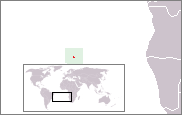Saint Helena crake
| Saint Helena crake | |
|---|---|
| Scientific classification | |
| Kingdom: | Animalia |
| Phylum: | Chordata |
| Class: | Aves |
| Order: | Gruiformes |
| Family: | Rallidae |
| Genus: | Porzana |
| Species: | P. astrictocarpus |
| Binomial name | |
| Porzana astrictocarpus Olson, 1973 | |
 | |
| Location of Saint Helena. | |
The Saint Helena crake (Porzana astrictocarpus) is an extinct bird species from the island of Saint Helena in the South Atlantic Ocean, one of two flightless rails which survived there until the early 16th century.[2]
After American ornithologist Alexander Wetmore described bones of the large Saint Helena swamphen (Atlantisia podarces) from Prosperous Bay, Saint Helena, in 1963, American paleontologist Storrs Olson found almost complete skeletons of the Saint Helena crake in the same region in 1973. These skeletons consist of bones which were smaller than the bones of Atlantisia podarces. Due to the peculiar shape of the carpometacarpus Olson named this species Porzana astrictocarpus.[2]
Olson proceeded on the assumption that the Saint Helena crake was a derivative of the Baillon's crake (Porzana pusilla), which is widespread in Europe and Africa. As there were no predators on Saint Helena, it had lost its ability to fly. However, when Saint Helena was colonised around 1502, the settlers brought a lot of mammals to the island, leading to the extinction of the Saint Helena crake.[2]
References
- ↑ BirdLife International (2012). "Porzana astrictocarpus". IUCN Red List of Threatened Species. Version 2013.2. International Union for Conservation of Nature. Retrieved 26 November 2013.
- 1 2 3 Storrs L. Olson, Paleornithology of St Helena Island, south Atlantic Ocean, Smithsonian Contributions to Paleobiology 23 (1975)
